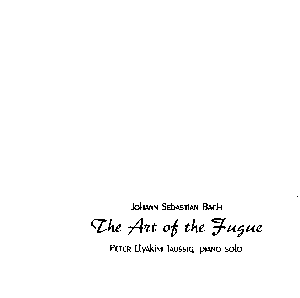Peter Elyakim Taussig is a Canadian recording artist
who lost the ability to play with his right hand due to Carpal Tunnel
Syndrome and arthritis. He invented 'Musical Sculpting' initially to
overcome his disability, this allows him to record any repertoire just
with his left hand and a computer mouse.
Allow me to quote extensively from Peter Taussig's
web page:
"Musical Sculpting is a technique for shaping
musical phrases using an acoustic concert grand piano connected to a
computer. The recordings are created on the Yamaha Disklavier PRO, a
reproducing piano that is capable of sending information into a computer
and in turn can be triggered or "played" by the computer.
"Musical Sculpting separates the process of playing
the notes from the process of shaping the music. Refining a musical
performance is no longer achieved through repetitive physical playing
but by manipulating the phrases in a graphic environment with a computer
mouse."
At first, one would think this leads to a purely metronomic
performance, one as rigid as a Swiss watch. This is not the case - and
is obvious from the very first fugue, which Taussig plays very slowly,
and with a flexible rhythm. Yet, as a stylistic choice, this fugue does
not work as well as it might - not that the tempo is wrong, or problematic,
but there is too much of a contrast between the first fugue and the
following fugue, which takes off at a very fast tempo, with almost syncopated
rhythm. Aside from the first fugue, the tempi are relatively rapid,
in fact, many of the fugues are faster than most other performances.
(The final fugue is, for my taste, too fast. The subtle interplay of
the many voices is lost in the rush.)
Taussig allows himself to alter the text slightly -
his ornaments, even runs, at times, can be a bit shocking, yet they
do fit in with the overall vision that slowly becomes apparent as one
listens to the entire work. Such ornamentation becomes apparent in the
second fugue, and in the very first notes of the fourth fugue.
If I didn't know how this disc was recorded, there
would certainly be nothing to suggest that the piano was not "played".
It lacks the mechanical, wooden rhythms that come through standard midi
performances, and the sound is truly that of a "real" piano.
Taussig claims that he could "modify and control the rubato, articulation
and dynamic shading of [his] recording" so "each voice assumed
a constant identity that could be maintained throughout the piece, something
nearly impossible to achieve in a real-time recording." It is hard
to say whether this works or not - at times, the left-hand part comes
through a bit louder than one usually hears it played; sometimes this
works, sometimes it submerges the treble part a bit. But, at other times,
there is a unique sense of texture. The three final fugues for two pianos
work surprisingly well, with a good level of definition among the different
voices (except for the tempo problem, which I mentioned above).
It should be noted that Taussig only plays the fugues
- the contrapunti -, which allows him to put this recording on just
one disc. The canons, which are left out, are an integral part of the
Art of Fugue, and it is a shame to have ignored most of them although
the canons are included as Contrapuncti 12-15 (their designation in
the manuscript).
In the end, how should this recording be judged? Taussig
is following in the footsteps of Glenn Gould, who posited the idea of
recordings as a new musical art form. Other recordings are made in bits
and pieces, with edits and splices galore - so should one condemn this
recording for its technique? I do not think so. Peter Taussig has recorded
a unique, personal interpretation of the Art of Fugue, and, no matter
how the recording was made, it stands on its own as a fine work. I would
perhaps have liked to hear a recording that is a bit closer to the text,
without Taussig's embellishments, but that, too, is part of his vision.
Compared to the many vapid recordings released by well-intentioned performers,
this at least has the merit of declaring a vision and following through
on it. For that reason alone, this disc is worth exploring. Few musicians
today dare realize originality. Kudos to Peter Taussig for having the
courage to do so
.
Kirk McElhearn
CONTACT DETAILS
http://crystalmusic.com/taussig/
